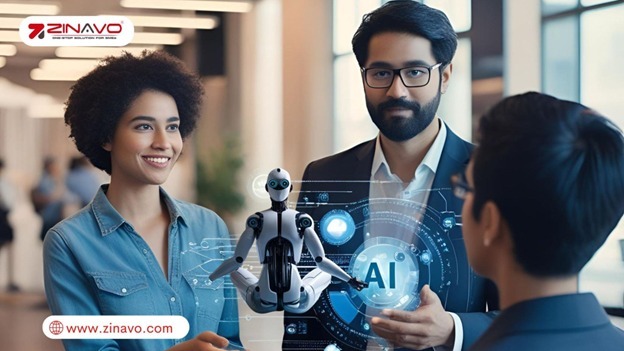How AI is Changing the Future of Digital Advertising?
Introduction:
Google search results, Facebook ads, and YouTube videos are all examples of digital advertising today. But have you ever wondered how brands know what to show you and when? Artificial Intelligence (AI) provides the solution. Using artificial intelligence, digital advertising has become smarter, faster, and more effective. In this blog, we’ll explain how AI is shaping the future of digital marketing and what it means for businesses and customers.
1. AI Makes Ads More Personalized
One of the biggest ways AI is changing advertising is through personalization. AI tools collect data about what people search, watch, and buy online. Then, they use this data to show ads that match people’s interests.
For example:
- If you search for “best smartphones,” you might see ads for mobile phones on Instagram or YouTube.
- If you often buy fitness products, AI will suggest gym equipment or health supplements.
- Personalized ads are more likely to grab your attention and lead to sales.
2. Smart Audience Targeting
Before AI, marketers had to guess who might be interested in their ads. Today, AI enables businesses to target the right audience with accuracy.
AI tools analyze:
- Age
- Location
- Interests
- Past behavior
This means your ad for baby products won’t be shown to someone who’s only searching for cars. This kind of smart targeting saves time and money and increases conversions.
3. Real-Time Ad Optimization
AI doesn’t stop after your ad goes live. It keeps working behind the scenes to optimize performance.
For example:
- If an ad is not performing well, AI can pause it and boost another one.
- It can adjust headlines, images, or even budgets based on performance.
- This is called real-time optimization, and it helps get better results without manual work.
4. Chatbots for Customer Engagement
AI-powered chatbots are now being used in digital ads and websites. They help answer customer questions instantly and guide them toward a purchase.
Benefits:
- Available 24/7
- Respond in seconds
- Save on customer service costs
For example, if you click on an ad for shoes, a chatbot might pop up and ask, “Do you need help choosing your size?”
5. AI in Programmatic Advertising
Programmatic advertising is when AI automatically buys and places ads for you based on data. The process is similar to putting your ad campaign on autopilot.
AI systems decide:
- Where to show the ad
- What time to show it
- Which platform to use
This helps reach the right people at the right time, with minimum human effort.
6. Voice Search and AI Assistants
More people are now using voice assistants like Siri, Alexa, or Google Assistant. AI helps businesses create ads that match voice search trends.
Example:
If someone says, “Find nearby pizza deals,” AI can ensure that a local pizza ad appears.
This opens a new door for marketers to target users who use voice commands.
7. Predictive Analytics for Better Campaigns
AI uses predictive analytics to guess what customers might want in the future. The study examines past trends, customer behavior, and market trends.
Businesses can then:
- Launch ads based on upcoming demand
- Avoid spending money on low-interest products
- Stay ahead of the competition
8. Better ROI (Return on Investment)
AI helps businesses spend money more wisely. Since AI tracks what’s working and what’s not, companies can make smarter decisions.
This leads to:
- Lower ad costs
- Higher sales
- Improved return on investment (ROI)
With AI, even small businesses can compete with big brands.
9. AI-Generated Ad Content
AI tools like ChatGPT, Jasper AI, and others are now used to write ad copy, generate images, and even create short videos.
This saves time and money in content creation and makes it easier to test multiple versions of an ad.
10. AI Improves User Experience
Lastly, AI improves the overall user experience. When people see relevant, helpful, and creative ads, they are more likely to trust the brand and take action.
For example:
AI ensures you don’t see the same ad repeatedly.
It adjusts ad formats based on your device (mobile, desktop, etc.).
It avoids showing ads that are not useful to you.
Comparison Table: Before AI vs With AI in Digital Advertising
| Feature | Before AI | With AI |
| Targeting | Broad and manual | Precise and data-driven |
| Ad Personalization | Limited | Highly personalized |
| Campaign Management | Manual | Automated with real-time optimization |
| Customer Support | Human agents | 24/7 AI chatbots |
| Content Creation | Done by marketers | AI-generated copy and visuals |
| Ad Placement | Fixed platforms | Cross-platform and smart bidding |
| Voice Search Ads | Not available | AI-optimized for smart speakers |
| Performance Tracking | Basic reports | Deep insights with predictive analytics |
Conclusion
Artificial intelligence has become more than a buzzword; it is a game-changing innovation in the world of digital advertising. AI helps businesses better connect with their customers through personalized advertising and smarter targeting. Whether you are a small business or a large brand, using AI in your digital ads can save time, reduce costs, and increase results.
As we look into the future, one thing is clear: AI is here to stay, and it’s shaping the next generation of digital advertising in ways we never imagined. Involving AI is not just a trend — it’s a smart move for long-term success.



